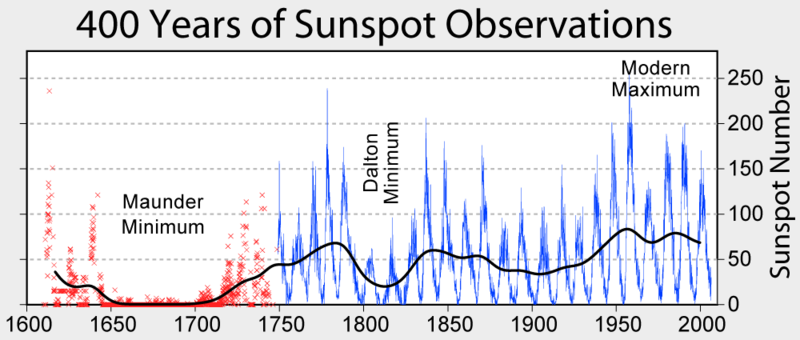We’ve been hearing a lot of bogus “model science” asking us to believe the preposterous notion that a warm Arctic and reduced sea ice there “could” lead to bitter cold winters across Europe and North America. In summary the new science insists warming leads to more cold. Now there’s a new paper out in the Geophysical Research Letters titled: Solar influence on winter severity in Central Europe, which tells us this is a load of BS.
The sun has a major impact on climate. And there’s no denying it: solar activity reached record levels over the 20th century. This file is licensed under the Creative Commons Attribution-Share Alike 3.0 Unported
The key points of the paper:
- Freezing of the Rhine occurred from 1780-1963 regularly during sunspot minima.
- Coldest winter continue to occur during sunspot minima even today.
- This cooling is a regional phenomenon, but not a hemispheric signal.
The authors used historical reports of freezing of the river Rhine. They concluude:
The historical data show that 10 of the 14 freeze years occurred close to sunspot minima and only one during a year of moderate El Niño. This solar influence is underpinned by corresponding atmospheric circulation anomalies in reanalysis data covering the period 1871 to 2008. Accordingly, weak solar activity is empirically related to extremely cold winter conditions in Europe also on such long time scales. This relationship still holds today, however the average winter temperatures have been rising during the last decades.”
The cause of the rising average winter temperatures over the last decades will be attributed by some to greenhouse gases. But we have to recall that the sun not only undergoes 11-year cycles, but also, 22, 87 and 1000-year cycles. In happens that solar activity was at a very high level over the last decades, and so warming over the last decade, especially in combination with the warm phases of the PDO and AMO, should not surprise us at all.
As the paper says, the sun plays a major role, and so ignoring its cycles in models is just bad science. The tragedy of it all is that the solar cycles are known and they could be easily built into the models, which then in turn would gain immensely in value. But because they do not produce the desired results for activist scientists, they are left out and forcing tricks from other factors such as aerosols and volcanoes are used for explaining the inconvenient cool periods.






There must be a coorelation between Solar Cycles and Human Stupidity. It’s obvious that the hotter it is the dumber we get; air conditioning doesn’t seem to offset the effect either. Looking at the chart, I’m really suprised we didn’t destroy the planet in the past 50 years; think maybe it was too hot to put all those ‘bright’ ideas into action. There also seems to be a connection between solar cycles, human stupidity, and the awarding of doctorates, let’s hope that as things cool off, as intelligence levels rise, that there will be a lot less PhD’s out there, especially the ones who like to dream up stupid solutions to non-existant problems and ruin young minds in classrooms and lecture halls.
WUWT recently (05Sept) discussed a similar claim: by Leal-Silv, M.C ; .M. Velasco Herrera (2012, „Solar forcing on the ice winter severity index in the Western Baltic region”Journal of Atmospheric and Solar-Terrestrial Physics, online 03, Sept.2012, http://wattsupwiththat.com/2012/09/05/solar-activity-linked-to-arctic-winter-severity/
For comparison, here is a graphic on sea ice cover in the western Baltic from 1500-2000 http://www.seaclimate.com/b/images/buch/big/B-19-.png
showing outside the Little Ice Age only a strong icing in the 1940s decade (actually 1940, 1941, 1942, and 1947) which happen to host the Second World War, discussed here: http://www.seaclimate.com/b/b.html
(section: f. Three sea ice years in succession )
Here is a fill in the blank exercise.
“. . . the sun plays a major role, . . . ”
It does this in the following manner – {big blank space}
“It does this in the following manner”
I’m becoming more and more confident that the primary causation in the first instance is an effect on the shape of the polar vortices from chemical changes in the atmosphere (more pronounced above the poles) induced by solar variability acting differentially on ozone amounts at different heights.
When the sun is active the polar vortices are strong vertically and contracted horizontally which pulls the jets and climate zones poleward allowing more energy into the oceans.
When the sun is inactive the vortices are weak vertically but flop about horizontally pushing the jets and climate zones equatorward allowing less energy into the oceans.
The consequences work through both air and ocean circulations on different timescales but overall an active sun gives less clouds and warming oceans whilst an inactive sun gives more clouds and cooling oceans.
The system response is to increase the speed of the hydrological cycle to eliminate extra warming when the sun is active and to decrease the speed of the hydrological cycle to try and preserve warmth when the sun is less active. In other words whatever happens the system response is negative and not positive as proposed by AGW theory.
As far as I can see that general mechanism covers all known observations.